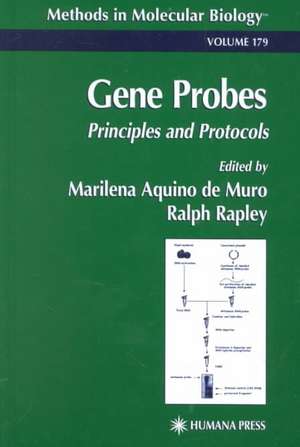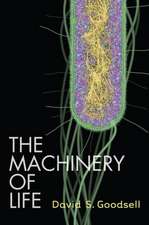Gene Probes: Principles and Protocols: Methods in Molecular Biology, cartea 179
Editat de Marilena Aquino do Muro, Ralph Rapleyen Limba Engleză Hardback – 20 sep 2001
| Toate formatele și edițiile | Preț | Express |
|---|---|---|
| Paperback (1) | 634.97 lei 6-8 săpt. | |
| Humana Press Inc. – 10 noi 2010 | 634.97 lei 6-8 săpt. | |
| Hardback (1) | 648.56 lei 6-8 săpt. | |
| Humana Press Inc. – 20 sep 2001 | 648.56 lei 6-8 săpt. |
Din seria Methods in Molecular Biology
- 9%
 Preț: 791.63 lei
Preț: 791.63 lei - 23%
 Preț: 598.58 lei
Preț: 598.58 lei - 20%
 Preț: 882.98 lei
Preț: 882.98 lei -
 Preț: 252.05 lei
Preț: 252.05 lei - 5%
 Preț: 802.70 lei
Preț: 802.70 lei - 5%
 Preț: 729.61 lei
Preț: 729.61 lei - 5%
 Preț: 731.43 lei
Preț: 731.43 lei - 5%
 Preț: 741.30 lei
Preț: 741.30 lei - 5%
 Preț: 747.16 lei
Preț: 747.16 lei - 15%
 Preț: 663.45 lei
Preț: 663.45 lei - 18%
 Preț: 1025.34 lei
Preț: 1025.34 lei - 5%
 Preț: 734.57 lei
Preț: 734.57 lei - 18%
 Preț: 914.20 lei
Preț: 914.20 lei - 15%
 Preț: 664.61 lei
Preț: 664.61 lei - 15%
 Preț: 654.12 lei
Preț: 654.12 lei - 18%
 Preț: 1414.74 lei
Preț: 1414.74 lei - 5%
 Preț: 742.60 lei
Preț: 742.60 lei - 20%
 Preț: 821.65 lei
Preț: 821.65 lei - 18%
 Preț: 972.30 lei
Preț: 972.30 lei - 15%
 Preț: 660.49 lei
Preț: 660.49 lei - 5%
 Preț: 738.41 lei
Preț: 738.41 lei - 18%
 Preț: 984.92 lei
Preț: 984.92 lei - 5%
 Preț: 733.29 lei
Preț: 733.29 lei -
 Preț: 392.60 lei
Preț: 392.60 lei - 5%
 Preț: 746.26 lei
Preț: 746.26 lei - 18%
 Preț: 962.66 lei
Preț: 962.66 lei - 23%
 Preț: 860.22 lei
Preț: 860.22 lei - 15%
 Preț: 652.64 lei
Preț: 652.64 lei - 5%
 Preț: 1055.50 lei
Preț: 1055.50 lei - 23%
 Preț: 883.87 lei
Preț: 883.87 lei - 5%
 Preț: 1141.13 lei
Preț: 1141.13 lei - 19%
 Preț: 491.89 lei
Preț: 491.89 lei - 5%
 Preț: 1038.86 lei
Preț: 1038.86 lei - 5%
 Preț: 524.16 lei
Preț: 524.16 lei - 18%
 Preț: 2122.34 lei
Preț: 2122.34 lei - 5%
 Preț: 1299.23 lei
Preț: 1299.23 lei - 5%
 Preț: 1339.12 lei
Preț: 1339.12 lei - 18%
 Preț: 1390.26 lei
Preț: 1390.26 lei - 18%
 Preț: 1395.63 lei
Preț: 1395.63 lei - 18%
 Preț: 1129.65 lei
Preț: 1129.65 lei - 18%
 Preț: 1408.26 lei
Preț: 1408.26 lei - 18%
 Preț: 1124.92 lei
Preț: 1124.92 lei - 18%
 Preț: 966.27 lei
Preț: 966.27 lei - 5%
 Preț: 1299.99 lei
Preț: 1299.99 lei - 5%
 Preț: 1108.51 lei
Preț: 1108.51 lei - 5%
 Preț: 983.76 lei
Preț: 983.76 lei - 5%
 Preț: 728.16 lei
Preț: 728.16 lei - 18%
 Preț: 1118.62 lei
Preț: 1118.62 lei - 18%
 Preț: 955.25 lei
Preț: 955.25 lei - 5%
 Preț: 1035.62 lei
Preț: 1035.62 lei
Preț: 648.56 lei
Preț vechi: 763.01 lei
-15% Nou
Puncte Express: 973
Preț estimativ în valută:
124.12€ • 134.77$ • 104.26£
124.12€ • 134.77$ • 104.26£
Carte tipărită la comandă
Livrare economică 23 aprilie-07 mai
Preluare comenzi: 021 569.72.76
Specificații
ISBN-13: 9780896038851
ISBN-10: 0896038858
Pagini: 272
Ilustrații: XI, 272 p.
Dimensiuni: 152 x 229 x 19 mm
Greutate: 0.64 kg
Ediția:2002
Editura: Humana Press Inc.
Colecția Humana
Seria Methods in Molecular Biology
Locul publicării:Totowa, NJ, United States
ISBN-10: 0896038858
Pagini: 272
Ilustrații: XI, 272 p.
Dimensiuni: 152 x 229 x 19 mm
Greutate: 0.64 kg
Ediția:2002
Editura: Humana Press Inc.
Colecția Humana
Seria Methods in Molecular Biology
Locul publicării:Totowa, NJ, United States
Public țintă
ResearchCuprins
Target Format and Hybridization Conditions.- End Labeling Procedures.- Photobiotin Labeling.- Nick Translation.- Random Primed Labeling.- Design and Evaluation of 16S rRNA-Targeted Oligonucleotide Probes for Fluorescence In Situ Hybridization.- Evaluation of Alterations in the Tumor Suppressor Genes INK4A and INK4B in Human Bladder Tumors.- The ?-Tubulin Gene Region as a Molecular Marker to Distinguish Leishmania Parasites.- Detection of Malignant Plasma Cells in the Bone Marrow and Peripheral Blood of Patients with Multiple Myeloma.- Detection of Chlamydia trachomatis by DNA Amplification.- Isolation and Identification of Campylobacter Species by Use of Selective Enrichment, Nucleic Acid Amplification Methods, and Gene Probes.- Diagnosis of Human Papillomavirus Using In Situ Hybridization and In Situ Polymerase Chain Reaction.- Quantitation of In Situ Hybridization Using Image Analysis of Radioactively Labeled RNA Probes.- Stable Isotope Probing for Detection of Methanotrophs After Enrichment with 13CH4.- Detection of Enterococci in Freshwater and Seawater (16S and 23S rRNA Enterococcus Oligonucleotide Probes).- Analysis of 16S–23S rRNA Intergenic Spacer of Vibrio cholerae and Vibrio mimicus for Detection of These Species.- Colony Hybridization of Bacterial Isolates with Burkholderia cepacia-Specific Probes.- In Situ Hybridization of Burkholderia cepacia Cells.- Detection of Polychlorinated Biphenyl-Degrading Organisms in Soil.- Detection of Single-Copy Genes in DNA from Transgenic Plants.- Differentiation Between Transcripts of Genes Belonging to Small Families During Fruit Ripening and Abscission.- Polymerase Chain Reaction Detection of Invasive Shigella and Salmonella enterica in Food.- Polymerase Chain Reaction for Detection of Listeria monocytogenes.
Recenzii
"In this book, the editors have brought together a comprehensive collection of time-tested protocols for designing and using gene probes in a wide variety of applications." -Clinical Laboratory International
Textul de pe ultima copertă
The use of nucleic acid or gene probes as cloning or diagnostic tools has promoted significant advances in human genome mapping and in the isolation and manipulation of genes generally. In Gene Probes, Marilena Aquino de Muro and Ralph Rapley have brought together an outstanding collection of time-tested protocols for designing and using gene probes in a wide variety of applications. The applications covered range from searching for specific genes in the human chromosome to the detection of microorganisms and their toxins in the environment and in food samples, as well as in the diagnosis of human disease. Each cutting-edge method includes practical hints and tips and is described in step-by-step detail by an expert who not only routinely uses the technique, but has also optimized it for experimental success. Helpful tutorials explain the principles of gene probe design, labeling, detection, target formation, and hybridization conditions.
Comprehensive and versatile, Gene Probes: Principles and Protocols provides a cutting-edge practical resource for all biochemists, microbiologists, and molecular biologists who are using this powerful new technology to advance medical, environmental, and food research today.
Comprehensive and versatile, Gene Probes: Principles and Protocols provides a cutting-edge practical resource for all biochemists, microbiologists, and molecular biologists who are using this powerful new technology to advance medical, environmental, and food research today.
Caracteristici
Includes supplementary material: sn.pub/extras








